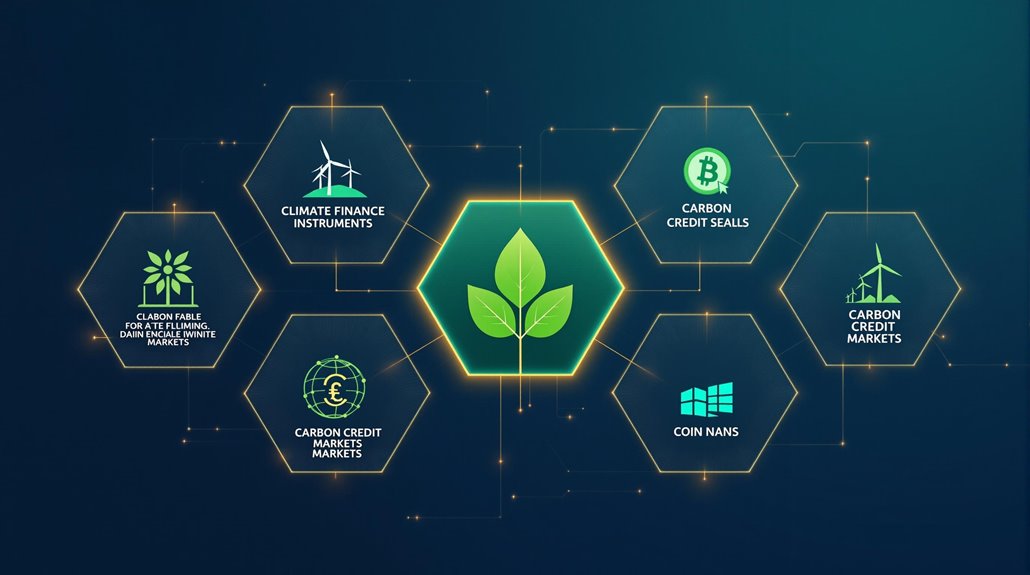Climate finance instruments in 2024 are dominated by green bonds, with cumulative issuance reaching USD 5.7 trillion, followed by climate resilience bonds targeting a $4.2 trillion labeled debt market. Key mechanisms include blended finance solutions, results-based financing, multilateral climate funds, concessional loans, grant programs, catastrophe bonds, carbon credit trading, and sustainability-linked performance bonds. These instruments collectively drive global climate action through innovative financing structures, while emerging trends suggest continued evolution in sustainable investment approaches.
The Rise of Climate Resilience Bonds

The emergence of Climate Resilience Bonds represents a significant evolution in sustainable finance, marking a departure from traditional green bonds by specifically targeting climate adaptation and resilience initiatives.
Climate Resilience Bonds pioneer a new frontier in sustainable finance, moving beyond green bonds to address urgent adaptation needs.
These innovative financial instruments tap into the $4.2 trillion labeled debt market while addressing resilience investment strategies across seven key themes: agriculture, health, infrastructure, cities, communities, industry, and biodiversity.
Operating within a structured taxonomy, they enable precise tracking of adaptation financing challenges and outcomes. The robust Climate Bonds Resilience Taxonomy provides standardized definitions and guidance for structuring these investments effectively.
The 2024 global rollout of these frameworks demonstrates growing recognition of resilience bonds as critical tools for “climate-proofing” vulnerable communities and sectors.
Notable examples include initiatives supporting women farmers in Uganda and wildfire preparedness programs in U.S. states, showcasing the instruments’ potential to drive targeted adaptation investments while delivering substantial co-benefits in poverty reduction and gender equality.
Concessional public funds play a crucial role in de-risking these investments and attracting private capital, particularly in developing economies where climate resilience needs are most urgent.
Green Bonds and Their Growing Market Impact
As global markets increasingly prioritize sustainable finance solutions, green bonds have emerged as the cornerstone of climate-focused investment vehicles, commanding approximately USD 5.7 trillion in cumulative issuance by mid-2024 and representing 60% of the total GSSS bond market.
The remarkable green bond growth trajectory, projected to reach USD 1,046.35 billion by 2032 at a 10.3% CAGR, reflects heightened investor confidence in sustainable investments.
Government entities dominate issuance with a 63% share, while private sector participation continues to expand.
Enhanced regulatory frameworks and standardized taxonomies have strengthened market integrity, attracting institutional investors seeking both environmental impact and financial returns.
Issuers must establish transparent governance structures to manage proceeds and demonstrate clear allocation of funds to eligible environmental projects.
The increasing scale of green bond issuance has improved market liquidity while channeling substantial capital into climate mitigation and adaptation projects worldwide.
The introduction of Climate Bonds Standard 4.0 has further reinforced transparency and credibility in the green bond market, providing investors with clearer guidelines for sustainable investments.
Blended Finance Solutions for Climate Action

Through strategic deployment of public and private capital, blended finance solutions have emerged as critical instruments for scaling up climate investments in 2024, with deals exceeding $1 billion becoming increasingly common despite challenging macroeconomic conditions.
These innovative blended finance models combine risk-mitigation instruments, including first-loss tranches and guarantees, with diverse financial products such as green loans and sustainability-linked bonds to enhance project bankability. The market has shown remarkable resilience with significant rebound in transaction volumes.
Over 70% of clean energy investment needed in emerging markets must come from private sources, making private capital mobilization essential for meeting climate goals. Current private sector funding reached $63 billion annually in 2021/22, marking a milestone in climate adaptation finance.
The focus has expanded beyond pure mitigation to include adaptation and nature-based solutions, with cross-cutting projects attracting new forms of blended capital in regions like Asia, Africa, and Latin America, particularly in sectors such as renewable energy, water infrastructure, and sustainable agriculture.
Results-Based Climate Financing Mechanisms
Results-based climate financing (RBCF) mechanisms have emerged as powerful instruments for driving verifiable climate action in 2024, building upon the momentum generated by blended finance approaches while introducing accountability through outcome-linked payments.
These RBCF mechanisms, which have channeled over USD 26 billion in development spending between 1993-2017, employ rigorous climate outcome verification protocols through third-party assessments to guarantee transparency and effectiveness.
The World Bank’s Program for Results (PforR) continues to lead implementation, particularly in developing nations, while new instruments focus on debt-neutral solutions such as shift bonds and performance-based contracts. This aligns with the World Bank Group’s commitment to deliver $42.6 billion in climate finance for fiscal year 2024.
Integration with national climate strategies and emphasis on institutional capacity building have proven essential for successful deployment, especially in Least Developed Countries and Small Island Developing States where enhanced access remains a priority. Country ownership principles ensure that climate finance mechanisms remain responsive to local needs while maintaining harmonized processes across funding institutions.
Multilateral Climate Fund Investments

The surge in multilateral climate fund investments has catalyzed unprecedented growth in global climate finance, reaching USD 1.46 trillion in 2022 with continued momentum through 2024.
Leading multilateral fund strategies have evolved through innovative mechanisms, including the CIF Capital Markets Mechanism and the Industry Decarbonization Program, which allocates $1 billion with a 50% private sector requirement. These initiatives reflect developed nations’ responsibility for historical emissions and their commitment to support climate action in developing countries.
The investment impact of these initiatives is amplified through enhanced partnerships between major climate funds and multilateral development banks, projecting USD 120 billion in annual climate finance for low- and middle-income countries by 2030. MDBs have demonstrated their commitment by providing record climate finance of $125 billion in 2023, with a significant focus on developing nations.
The Green Climate Fund (GCF), Climate Investment Funds (CIF), Global Environment Facility (GEF), and Adaptation Fund have strengthened their collaborative frameworks through AI-powered tracking platforms and transparent digital tools, ensuring efficient resource allocation and project visibility.
Carbon Credit Trading and Offset Markets
Building upon multilateral climate finance mechanisms, carbon credit trading and offset markets have emerged as powerful instruments for achieving global emissions reduction targets. The global carbon credit market, valued at USD 669.37 billion in 2024, demonstrates the significant scale of these financial mechanisms in addressing climate change.
- Carbon credit mechanisms operate through both compliance and voluntary markets, with trading platforms facilitating transparent transactions and ensuring single-use accountability in emissions reduction. The market saw 305 million tons of credits issued in 2024, marking significant growth in available offset options.
- Europe maintains market leadership with a 40% share, driven by sophisticated frameworks like the EU Emissions Trading System (EU ETS) and robust carbon pricing mechanisms.
- Trading platforms have evolved into essential market infrastructure, with the sector projected to grow from USD 131.40 million in 2024 to USD 632.10 million by 2034, reflecting increased institutional adoption and market maturity.
Concessional Loans for Climate Projects
While global climate finance mechanisms continue to evolve, concessional loans have emerged as a critical instrument for accelerating climate action, particularly in emerging markets and developing economies (EMDEs).
The UNFCCC Global Stocktake and IHLEG projections indicate a necessary fivefold increase in concessional financing by 2030, with EMDEs requiring USD 80-100 billion annually.
Concessional loan effectiveness is demonstrated through their ability to reduce project risk and catalyze private investment across key sectors including energy, transport, and climate resilience.
Multilateral development banks and development finance institutions lead these efforts, providing below-market terms that enable transformational projects otherwise deemed commercially unviable.
The blended finance approach has proven especially valuable, with each concessional dollar mobilizing multiple dollars of private capital for climate solutions.
Recent data shows that bilateral development institutions provide 33% of international concessional climate finance, making them the largest contributors to global climate funding initiatives.
Climate-Focused Grant Programs and ODA
As global climate action accelerates in 2024, grant programs and Official Development Assistance (ODA) have emerged as cornerstone instruments for channeling critical funding toward emissions reduction and climate resilience initiatives.
The unprecedented scale of climate grant efficacy is exemplified by the $150 billion in U.S. federal funding, while ODA alignment with Paris Agreement targets continues to evolve. Recent successes have demonstrated how philanthropic collaboration platforms are amplifying the impact of climate funding initiatives.
Key developments in climate-focused grant programs include:
- The $27 billion Greenhouse Gas Reduction Fund, with $20 billion allocated to national clean investment initiatives
- Implementation of the $5 billion Climate Pollution Reduction Grants program supporting state and city climate action plans
- Distribution of nearly $9 billion in Home Energy Rebate programs across 14 states for energy efficiency upgrades
These instruments particularly target vulnerable communities while fostering institutional partnerships between governments, financial intermediaries, and local organizations.
Catastrophe Bonds and Climate Risk Insurance
The catastrophe bond market‘s unprecedented growth to $17.7 billion in 2024 exemplifies the rapid evolution of climate risk transfer solutions in global financial markets.
Insurance-linked securities have emerged as sophisticated mechanisms for redistributing climate-related risks while generating attractive yields, with cat bond returns reaching 8.4% despite $145 billion in natural disaster losses.
This expansion of risk transfer instruments, coupled with parametric insurance products and multi-hazard pooling schemes, demonstrates the financial sector’s increasing capacity to address climate vulnerabilities through market-based resilience solutions. The adaptation and resilience spending has become increasingly critical as extreme weather events continue to highlight the need for robust insurance sector involvement.
Risk Transfer Solutions Evolving
Surging to unprecedented levels in 2024, catastrophe bonds and climate risk insurance solutions have emerged as pivotal instruments for transferring climate-related financial risks from insurers to capital markets.
The remarkable growth in cat bond diversification, reaching nearly $50 billion in market size, has bolstered investor confidence through enhanced transparency and sophisticated risk modeling. Despite global insured losses reaching $145 billion, the catastrophe bond market demonstrated exceptional resilience throughout 2024.
Market evolution has demonstrated transformative developments across multiple dimensions:
- Record-breaking issuance of $17.7 billion in catastrophe bonds, representing a 7% year-over-year increase
- Integration of advanced analytics and quantitative climate modeling for precise risk assessment
- Expansion beyond traditional perils to include cyber-risk and private transactions, while delivering returns up to 8.4%
This dynamic growth trajectory signals a maturing market poised for continued innovation in climate risk transfer solutions.
Insurance-Backed Climate Resilience
Insurance-backed climate resilience mechanisms have transformed catastrophic risk management through sophisticated financial instruments that safeguard vulnerable populations and critical infrastructure against extreme weather events.
Catastrophe bonds and parametric insurance solutions have emerged as cornerstone instruments, with 2024 witnessing increased issuance by governments and multilateral institutions for drought, flood, hurricane, and wildfire coverage.
The implementation of insurance subsidies through initiatives like Humanity Insured has extended protection to 3.6 billion people in climate-vulnerable areas, fostering resilient communities through rapid post-disaster recovery. The IFRC’s indemnity policy represents a groundbreaking shift in humanitarian insurance by covering broader disaster scenarios without event-specific limitations.
The National Association of Insurance Commissioners’ Climate Resilience Strategy, adopted in 2024, further strengthens this framework by promoting availability and affordability of coverage while incentivizing risk reduction measures through strategic pricing mechanisms and coverage mandates.
Sustainability-Linked Performance Bonds
Sustainability-linked performance bonds represent an innovative financial instrument where the terms and conditions, particularly interest rates, are directly tied to the achievement of predefined environmental, social, and governance metrics.
The flexible structure allows issuers to allocate capital across their operations while maintaining accountability through specific Key Performance Indicators (KPIs) and Sustainability Performance Targets (SPTs). The 2024 version of Sustainability-Linked Bond Principles provides enhanced guidance on KPI selection and definitions to ensure robust measurement of sustainability progress.
This mechanism creates a dynamic risk profile that appeals to both traditional fixed-income investors seeking market returns and impact-focused stakeholders pursuing measurable sustainability outcomes.
Performance Metrics Drive Terms
The intricate relationship between performance metrics and financial terms forms the cornerstone of Sustainability-Linked Bonds (SLBs), where predetermined Key Performance Indicators (KPIs) and Sustainability Performance Targets (SPTs) directly influence coupon rates and other economic conditions.
This performance-driven structure guarantees issuers face tangible financial penalties for failing to meet sustainability performance objectives. The instrument’s success is reinforced by strong market credibility from major financial institutions.
The 2024 Sustainability-Linked Bond Principles establish rigorous frameworks for metric selection and verification:
- KPIs must demonstrate materiality, measurability, and external verifiability while aligning with corporate sustainability strategies
- SPTs require ambitious benchmarking against sector pathways and historical performance data
- Regular public reporting mandates transparency on target progress, with clear documentation of consequences for underperformance
Flexible Investment Risk Profile
Modern sustainable finance markets demonstrate remarkable flexibility through performance-linked bonds that enable dynamic risk-return profiles based on achievement of predetermined environmental and social targets. This innovative structure allows organizations to pursue extensive sustainability improvements while maintaining financial adaptability.
The flexible allocation model empowers issuers to direct capital across multiple operational initiatives simultaneously, optimizing their path to meeting sustainability targets. Rather than restricting funds to specific green projects, organizations can implement enterprise-wide transformations that address both immediate and long-term environmental challenges. The utilization of Key Performance Indicators provides measurable benchmarks for tracking progress toward sustainability goals.
This approach particularly benefits companies undergoing complex sustainability changes, as it provides the necessary financial flexibility while maintaining accountability through performance-linked incentives. The risk profile adjusts according to target achievement, creating a balanced framework that serves both issuer operational needs and investor sustainability objectives.
Frequently Asked Questions
How Do Smaller Cities Access Climate Finance Without Established Credit Ratings?
Smaller cities without established credit ratings can access climate finance through multiple alternative funding pathways and community partnerships.
Key strategies include:
- Participating in municipal consortia to aggregate projects and enhance collective borrowing power
- Leveraging technical assistance programs from development banks
- Securing grants from international climate funds
- Building public-private partnerships for infrastructure projects
- Strengthening own-source revenues through local taxes and fees
- Engaging with NGOs and philanthropic organizations for targeted support
What Role Do Central Banks Play in Regulating Climate Finance Instruments?
Central banks regulate climate finance instruments through multiple channels, primarily via supervisory oversight and monetary policy frameworks.
They establish guidelines for green bonds issuance, implement climate risk disclosure requirements, and integrate environmental considerations into capital adequacy requirements.
Through the Network for Greening the Financial System (NGFS), central banks coordinate internationally to develop standardized approaches for evaluating climate-related financial risks and promoting sustainable finance practices across jurisdictions.
How Are Indigenous Communities Involved in Climate Finance Decision-Making Processes?
Indigenous communities are increasingly participating in climate finance decision-making through enhanced community representation and recognition of Indigenous rights.
Their involvement manifests through specialized platforms at COP conferences, direct funding mechanisms that bypass intermediaries, and integration of traditional ecological knowledge into project design.
Major climate funds, including the Green Climate Fund, are implementing new frameworks that prioritize Indigenous consultation and self-determined project ownership, though formal recognition as distinct constituencies remains limited in some institutions.
Can Retail Investors Participate in Large-Scale Climate Finance Initiatives?
Retail investors can increasingly participate in large-scale climate finance initiatives through multiple channels.
Specialized crowdfunding platforms enable direct investment in renewable energy projects with lower minimum thresholds, while impact investments through ETFs and mutual funds provide exposure to climate-focused companies and green bonds.
Digital investment platforms have democratized access by offering fractional shares, and many retirement accounts now incorporate climate-conscious investment options, making sustainable finance more accessible to individual investors.
What Cybersecurity Measures Protect Digital Climate Finance Transactions and Data?
Digital climate finance platforms employ robust cybersecurity measures centered on data encryption and thorough transaction security protocols.
These systems utilize multi-factor authentication, end-to-end encryption, and Zero Trust architectures to safeguard sensitive financial data.
Advanced threat detection mechanisms, including AI-driven monitoring and real-time anomaly detection, work alongside strict regulatory compliance frameworks to protect against unauthorized access and cyber threats.
Regular security audits and penetration testing further reinforce these protective measures.
Conclusion
As climate finance continues to evolve in 2024, these innovative financial instruments represent critical mechanisms for mobilizing capital toward climate action and resilience. Through the strategic deployment of bonds, blended finance solutions, and results-based mechanisms, the global financial sector demonstrates increasing sophistication in addressing climate challenges. These instruments, collectively managing trillions in climate-focused capital, will prove instrumental in achieving international climate goals and facilitating the shift to a low-carbon economy.
References
- https://www.climatepolicyinitiative.org/publication/global-landscape-of-climate-finance-2024/
- https://climatefundsupdate.org/publications/the-global-climate-finance-architecture-4/
- https://www.climatepolicyinitiative.org/publication/understanding-global-concessional-climate-finance-2024/
- https://napglobalnetwork.org/innovative-financing/
- https://infrastructuretransparency.org/news/our-2024-highlights-in-climate-change-and-finance/
- https://www.climatebonds.net/resilience
- https://www.climatebonds.net/our-expertise/resilience-finance
- https://www.climatepolicyinitiative.org/wp-content/uploads/2024/09/InvestHer-Climate-Resilience-Bond_Instrument-Analysis.pdf
- https://www.savetheredwoods.org/get-involved/take-action/raise-your-voice-in-support-of-climate-bond/
- https://www.climateproof.news/p/cwnyc-a-new-blueprint-for-building-climate-resilience-bonds

